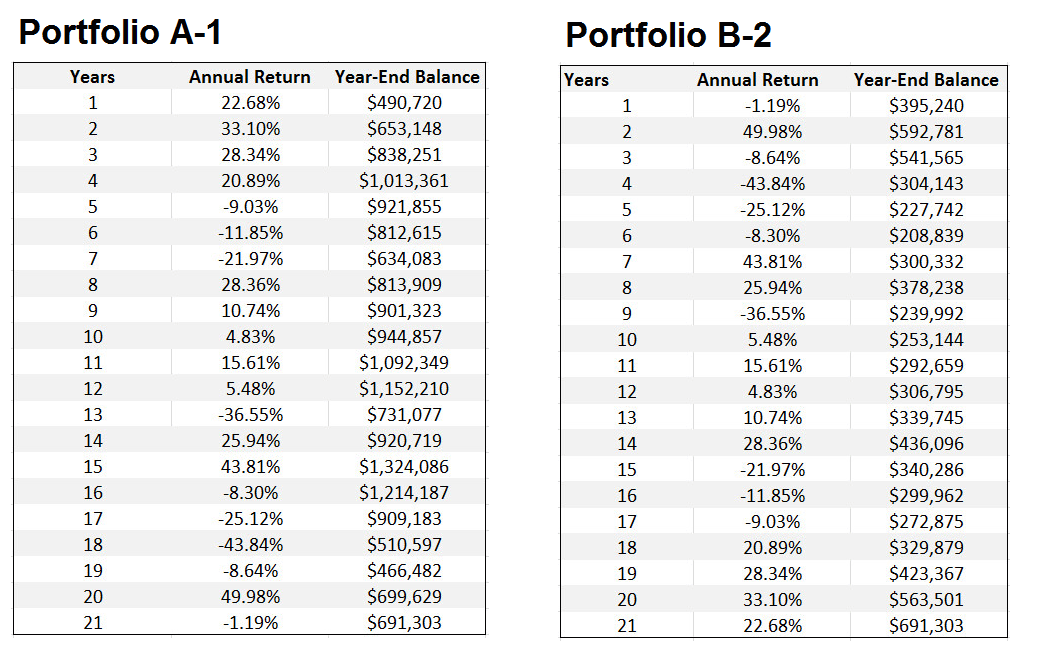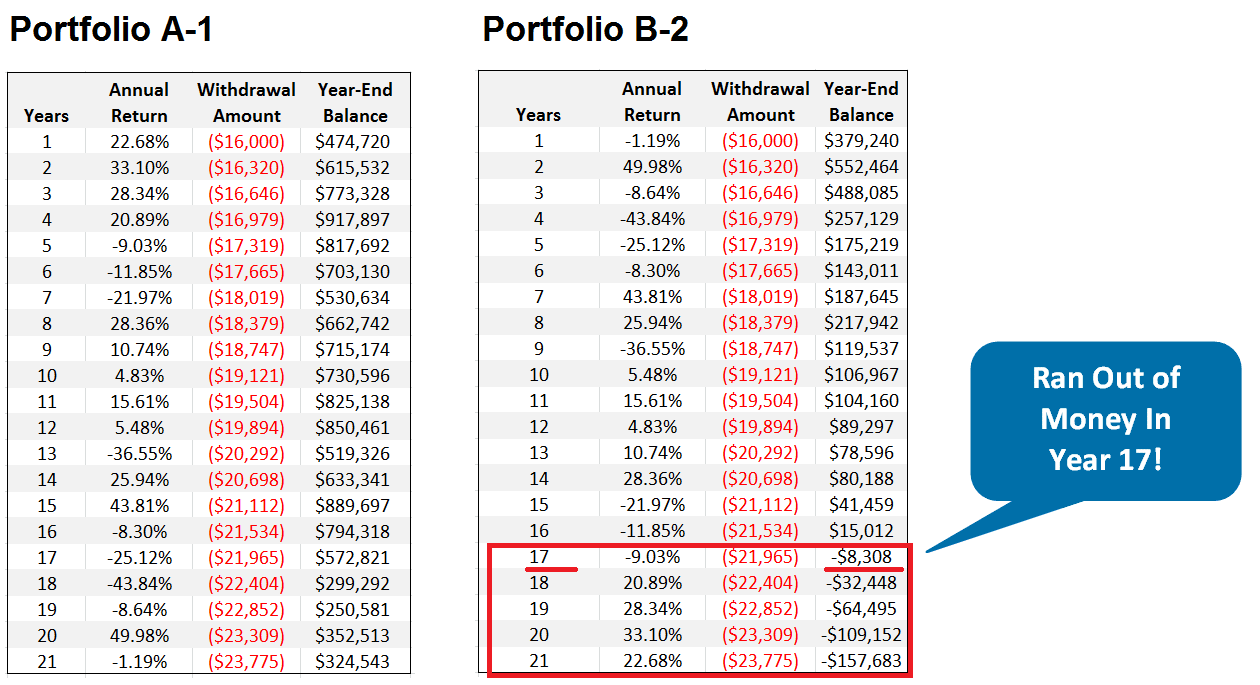Sequence of Returns Risk in Retirement

Most people would be thrilled at the prospect of 10% average annual returns or higher in retirement. But now that folks are living longer, they face more challenges than just adequate returns. With decades of retired living on the horizon, people must ensure their portfolios last as long as they might need them.
Sequence of returns risk can affect your long-term income the most in your early-retirement years. That is the timespan just before and right after you retire. You may have heard of that period called the “retirement red zone,” or generally the 10-year spread prior to and after retirement.
It’s true that average returns (including dividends) for the S&P 500 from 1928 to 2021 have exceeded 10%. But averages can be deceiving for long-term income planning. What matters just as much is the order of returns, or the actual timing of when a portfolio grows or loses value. As we will see, losses in those early years could make or break your income goals, setting up the risk of running out of retirement money.
This potential hazard is called sequence of returns risk, or just sequence risk. To illustrate it, we will talk about it in two formats: by analogy and then through two hypothetical portfolio scenarios.
What is Sequence Risk?
Imagine that you have two gardens. You plant identical vegetable seeds in each so that you can grow your own food.
Early in the growing stage, Garden 1 experiences blight. Not all the vegetables make it. You still have a small crop, but each time you pull a vegetable to eat, you are leaving less and less behind to continue growing.
By contrast, Garden 2 progresses and gives you a great first crop and seeds for your next planting. You keep planting, canning, and stockpiling the harvests along the way. Then Garden 2 experiences blight. But you can continue to eat well because the blight hit after Garden 2 had produced crops. You will be able to eat while the garden recovers from blight and can potentially grow vegetables again.
This, in a nutshell, is an example of sequence of returns risk. It’s a scenario in which having portfolio losses early in the game, when you might start drawing on that portfolio for income, could mean you have to play catch-up for the rest of your retirement.
Sequence Risk in Action
Now, let’s take a look at two hypothetical portfolio scenarios. In the first, both portfolios will be tracked over a 21-year period. The order of annual returns for the second portfolio will be reversed so we have negative returns showing up in the early years of our 21-year performance period.
Here’s an overview of our assumptions.
Hypothetical Retirement Portfolios: Scenario 1
- Names of Portfolios: Portfolio A-1 and Portfolio B-2
- Starting Portfolio Values: $400,000
- Number of Years: 21, including one extra for 20 years of performance
- Portfolio A-1 Performance Range: S&P 500 index calendar-year total returns, 1996-2016, includes reinvested dividends
- Portfolio B-2 Performance Range: Reversed order of same S&P 500 index calendar-year total returns
- Source: Aswath Damodaran, New York University Stern School of Business, data from FRED database of Federal Reserve Bank of St. Louis

Even with the order of returns reversed, both portfolios ended up with the same final value of $691, 303. Now, what happens when annual withdrawals are introduced?
Hypothetical Retirement Portfolios: Scenario 2
- Names of Portfolios: Portfolio A-1 and Portfolio B-2
- Starting Portfolio Values: $400,000
- Number of Years: 21, including one extra for 20 years of performance
- Portfolio A-1 Performance Range: S&P 500 index calendar-year total returns, 1996-2016, includes reinvested dividends
- Portfolio B-2 Performance Range: Reversed order of same S&P 500 index calendar-year total returns
- Portfolio Withdrawals: Annual withdrawals starting at $16,000 with withdrawal rate of 4%
- Inflation: Increasing withdrawal amounts by 2% annually to account for inflation
- Source: Aswath Damodaran, New York University Stern School of Business, data from FRED database of Federal Reserve Bank of St. Louis

Here, the second portfolio ran out of money in Year 17, with its account balance shooting below zero.
How Can Sequence of Returns Risk Affect Your Retirement?
For the unlucky who retired in 2008, during which the S&P 500 fell 37%, their retirement savings were significantly depleted.
While the market would recover, they had fallen so deeply into a hole that it would be difficult to reach the retirement account balances they were on track to achieve. And what if they had already started drawing on income from those accounts? Then the path to recovery would have been even harder.
With that seismic event in the rear-view mirror, some pundits have advocated for retirement income strategies that project lower “failure rates.” But respected author Wade Pfau, Ph.D., CFA®, a foremost authority on the subject, has an alternative take.
He writes, “The idea that retirees should focus on finding a spending strategy that maintains a rather low failure rate, as is par for the course with safe withdrawal rate studies, is not adequate.”
Why? Because, in everyday life, people don’t fail at 23% or 55%. They either succeed or fail. It’s a binary split of potential outcomes. In fact, when communicating in laymen’s terms, many people would say they succeed or fail “100%.”
Why Do These Strategies Fall Short?
The same is true when you either have enough retirement income to sustain you or you deplete it in your early years as a result of a threat like sequence-of-returns risk.
Writing for RetirementResearcher.com, Pfau explains that the narrow focus on a lower failure rate may fall short:
“[It] ignores the lost potential enjoyment from spending more even if it means having to cut back later, it ignores how much flexibility retirees may have to cut their spending at a later date, it ignores the other availability of spending resources outside of the financial portfolio, it ignores the probability of still being alive in late retirement, it ignores any goals to leave a bequest, and it ignores potentially how long the ‘failure’ condition may last.”
Pfau’s answer? “Retirees need to be thinking about a more complete model that incorporates these considerations when developing their retirement income strategies.”
What’s in Your Portfolio?
While studies and past generational data give some barometers for portfolio and spending strategies, you as an individual investor are so unique that those guidelines are likely to be statistically insignificant for you.
That means that the responsibility is yours to examine your individual circumstances and determine what will help you (and your partner) achieve your specific goals in retirement. You may consider working alongside a financial professional who understands these goals.
Are you a perpetual market chaser, even in retirement? As inflation continues to rise, compounding growth of assets is important, since you no longer have the sources of income you had while you worked to fuel your household spending needs.
But perhaps just as more important is holding on to what you have. Evaluate your current retirement income plan and ask the tough question: Would my retirement income plan survive the pressure of sequence of returns risk? Consider incorporating financial vehicles that may help reduce the risk during your retirement.
Risk-Averting Action Items
Knowing that the retirement-savings rug could be pulled out from under you, be sure to consider the dynamics of the market. No one also knows what markets will do in the future.
Short of having a crystal ball, discuss with your financial professional what this could mean for you. Discuss your asset allocation and consider pursuing a lower level of market risk.
If an objective analysis of your financial picture shows it makes sense for you — think about diverting part of your retirement nest egg toward strategies that provide guaranteed income, no matter how the market performs.
Consider all the ways you can preserve the savings and assets you have built over the years. And make sure your plan equips you to maximize spendable income after fees, inflation, and taxes.
Plan to Manage Risk and Retire Comfortably
You need to have enough left over to enjoy your life and grow your financial garden. When you are ready for professional guidance with tending and maintaining the progress of your income plan, financial professionals at SafeMoney.com can help you.
Use our “Find a Financial Professional” section to connect with someone directly. Should you need a personal referral, call us at 877.476.9723.








